Abstract
The bacteriologic and clinical efficacies of 3 days of lomefloxacin therapy were compared with those of 3 days of norfloxacin therapy for the treatment of acute uncomplicated urinary tract infections in a prospective, randomized, double-blind study. One hundred sixty-four subjects were enrolled at five Canadian centers; 84 received lomefloxacin, and 80 received norfloxacin. Escherichia coli (84%) and Staphylococcus saprophyticus (11%) were the most common organisms isolated. Forty subjects (24%) had low quantitative counts in their pretherapy urine specimens. In the intent-to-treat analysis, 76 lomefloxacin subjects (91%) and 76 norfloxacin subjects (95%) were cured or improved at follow-up 5 to 9 days posttreatment and 73 (87%) and 71 (89%) subjects from the lomefloxacin and norfloxacin groups, respectively, were cured or improved at 4 to 6 weeks posttreatment. Bacteriologic eradication occurred in 61 of 63 lomefloxacin subjects (97%) with > or = 10(8) CFU/liter in their pretherapy specimens and 56 of 59 norfloxacin subjects (95%) at 5 to 9 days and 55 (87%) and 53 (90%) subjects from the lomefloxacin and norfloxacin groups, respectively, at 4 to 6 weeks. There were no statistically significant differences in outcome. Adverse effects which were potentially related to the study medications were reported by 26% of the subjects who received lomefloxacin and 25% of the subjects who received norfloxacin. There were no severe adverse events, and only one subject discontinued therapy. These data suggest that 3 days of therapy with either lomefloxacin or norfloxacin is effective in the treatment of acute uncomplicated urinary tract infections.
Full text
PDF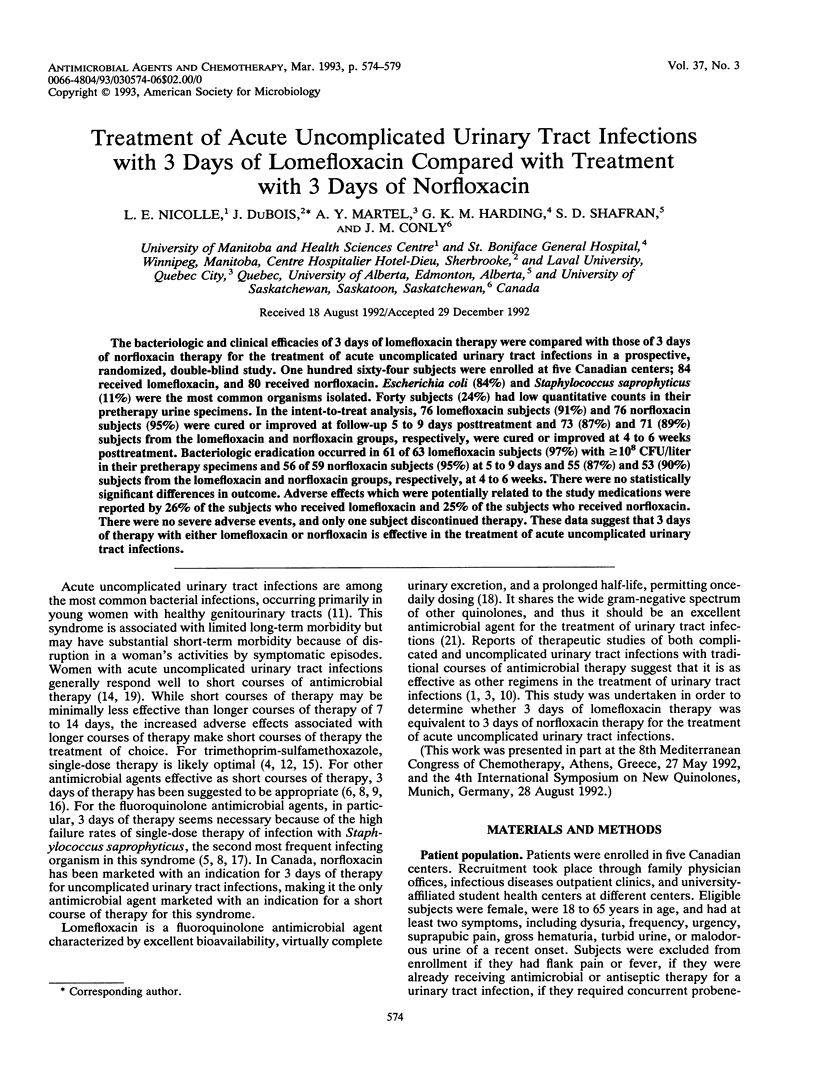
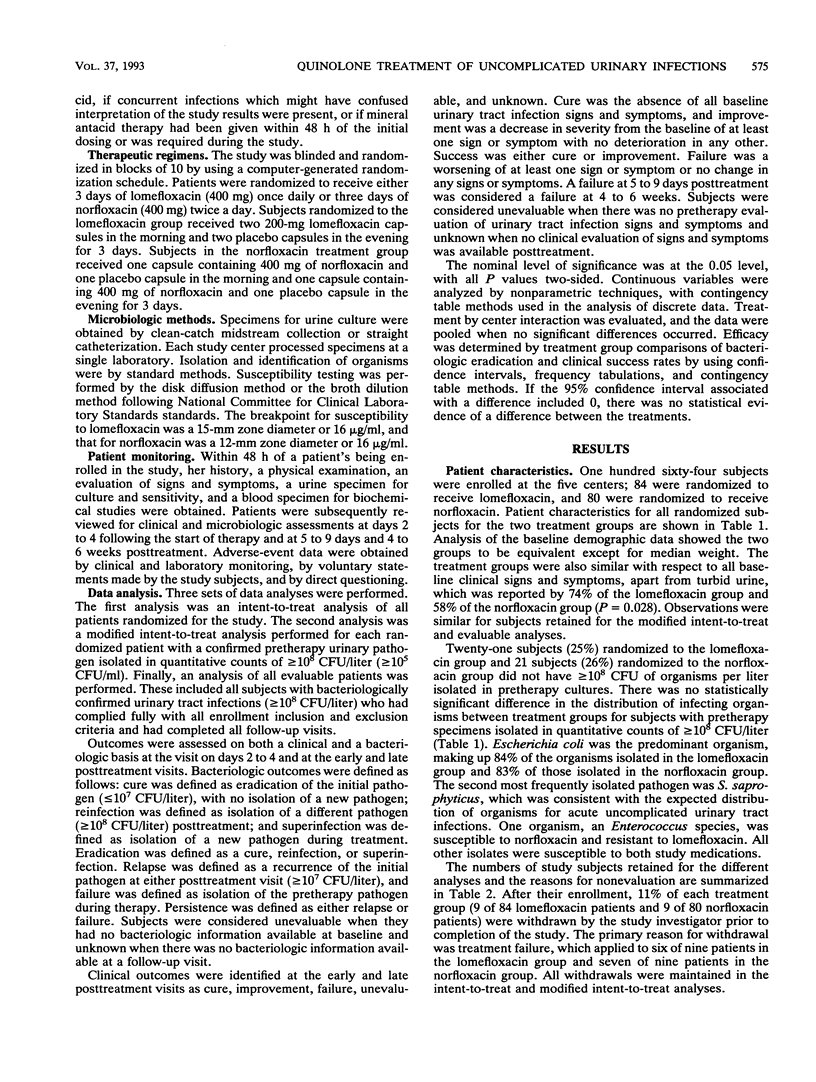
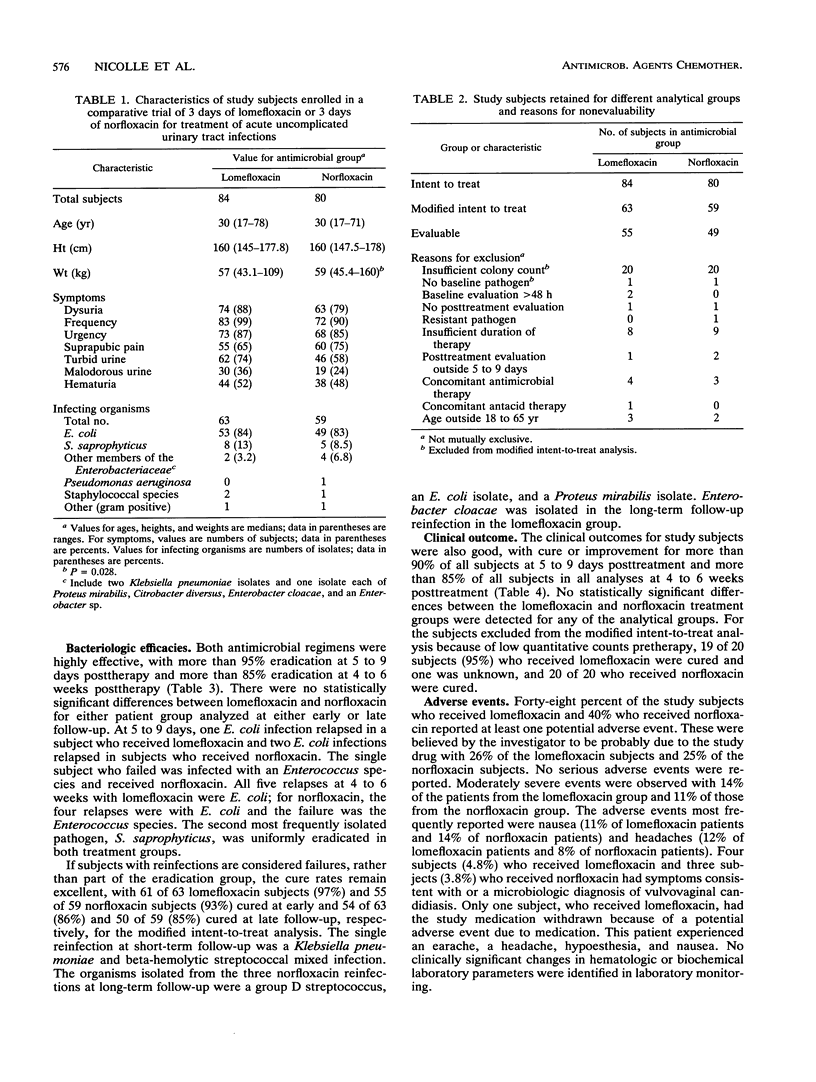
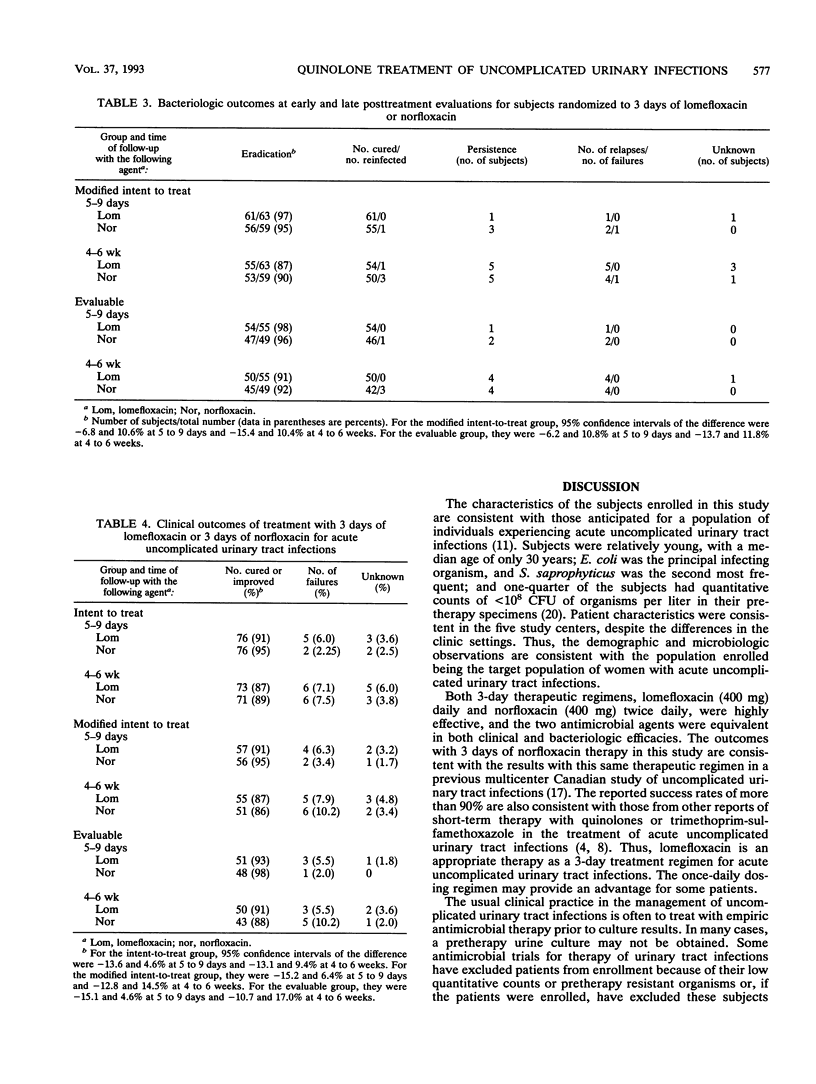
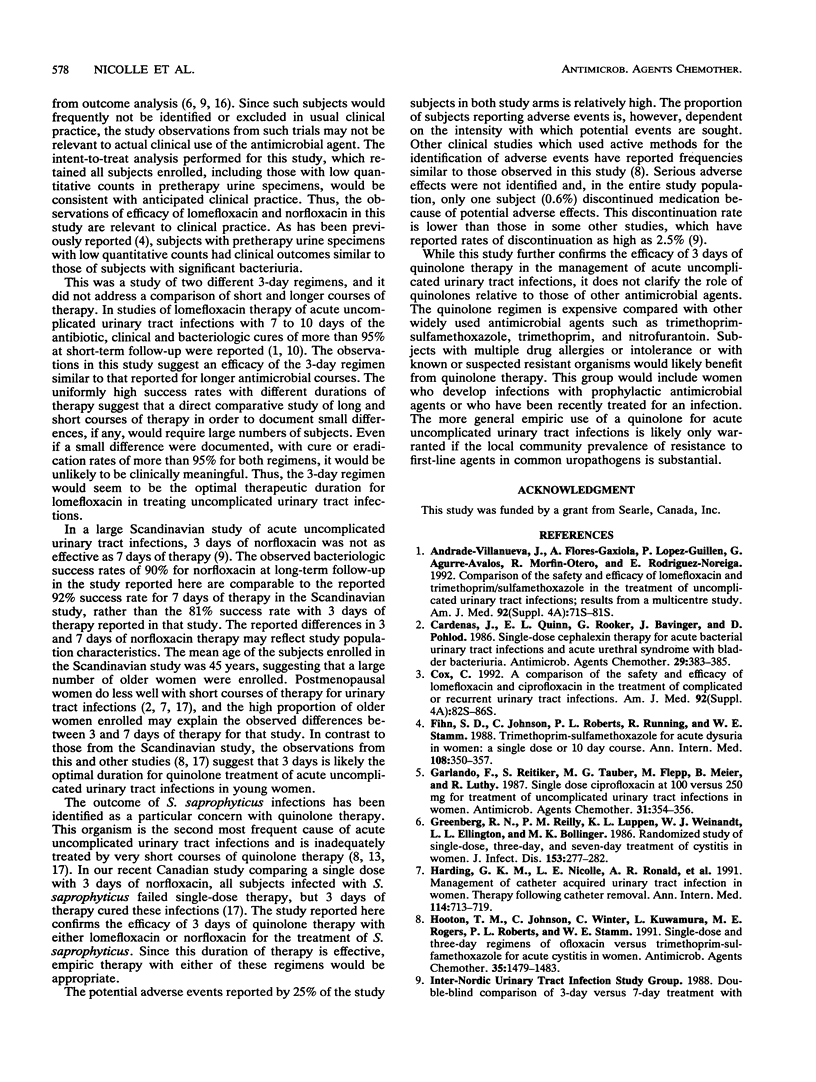
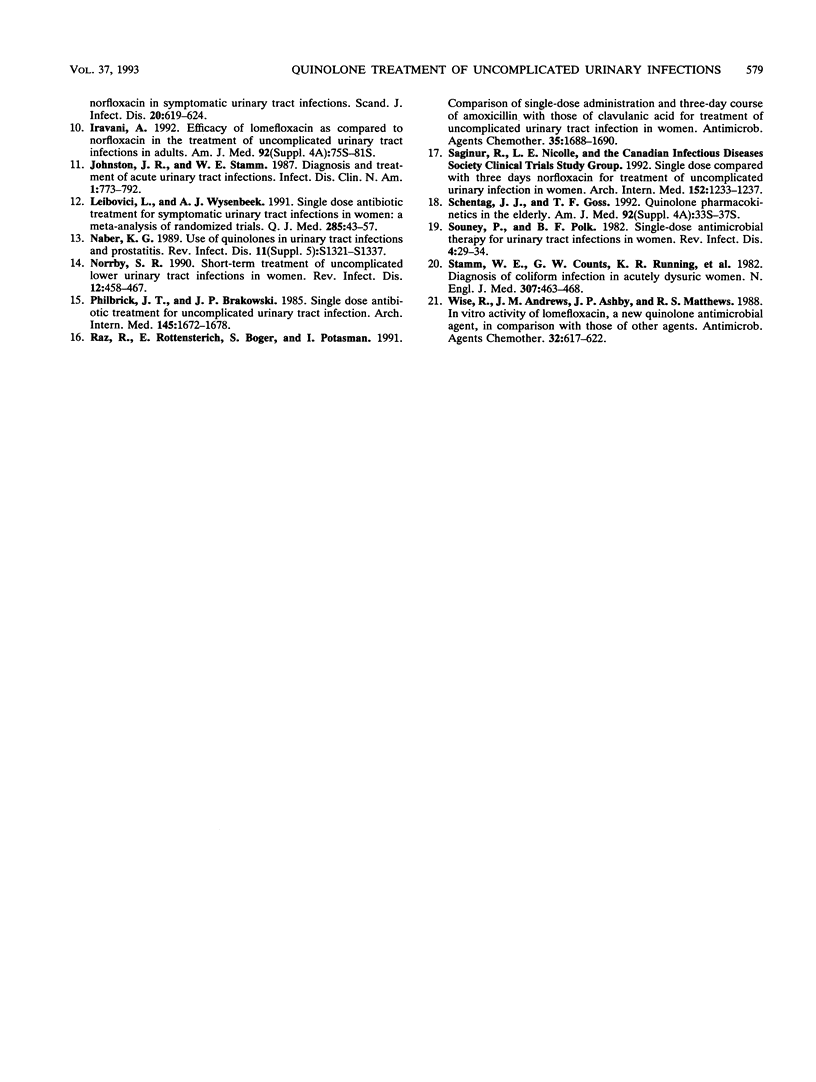
Selected References
These references are in PubMed. This may not be the complete list of references from this article.
- Andrade-Villanueva J., Flores-Gaxiola A., Lopez-Guillen P., Aguirre-Avalos G., Morfin-Otero R., Rodriguez-Noriega E. Comparison of the safety and efficacy of lomefloxacin and trimethoprim/sulfamethoxazole in the treatment of uncomplicated urinary tract infections: results from a multicenter study. Am J Med. 1992 Apr 6;92(4A):71S–74S. doi: 10.1016/0002-9343(92)90313-z. [DOI] [PubMed] [Google Scholar]
- Cardenas J., Quinn E. L., Rooker G., Bavinger J., Pohlod D. Single-dose cephalexin therapy for acute bacterial urinary tract infections and acute urethral syndrome with bladder bacteriuria. Antimicrob Agents Chemother. 1986 Mar;29(3):383–385. doi: 10.1128/aac.29.3.383. [DOI] [PMC free article] [PubMed] [Google Scholar]
- Cox C. E. A comparison of the safety and efficacy of lomefloxacin and ciprofloxacin in the treatment of complicated or recurrent urinary tract infections. Am J Med. 1992 Apr 6;92(4A):82S–86S. doi: 10.1016/0002-9343(92)90315-3. [DOI] [PubMed] [Google Scholar]
- Fihn S. D., Johnson C., Roberts P. L., Running K., Stamm W. E. Trimethoprim-sulfamethoxazole for acute dysuria in women: a single-dose or 10-day course. A double-blind, randomized trial. Ann Intern Med. 1988 Mar;108(3):350–357. doi: 10.7326/0003-4819-108-3-350. [DOI] [PubMed] [Google Scholar]
- Garlando F., Rietiker S., Täuber M. G., Flepp M., Meier B., Lüthy R. Single-dose ciprofloxacin at 100 versus 250 mg for treatment of uncomplicated urinary tract infections in women. Antimicrob Agents Chemother. 1987 Feb;31(2):354–356. doi: 10.1128/aac.31.2.354. [DOI] [PMC free article] [PubMed] [Google Scholar]
- Greenberg R. N., Reilly P. M., Luppen K. L., Weinandt W. J., Ellington L. L., Bollinger M. R. Randomized study of single-dose, three-day, and seven-day treatment of cystitis in women. J Infect Dis. 1986 Feb;153(2):277–282. doi: 10.1093/infdis/153.2.277. [DOI] [PubMed] [Google Scholar]
- Harding G. K., Nicolle L. E., Ronald A. R., Preiksaitis J. K., Forward K. R., Low D. E., Cheang M. How long should catheter-acquired urinary tract infection in women be treated? A randomized controlled study. Ann Intern Med. 1991 May 1;114(9):713–719. doi: 10.7326/0003-4819-114-9-713. [DOI] [PubMed] [Google Scholar]
- Hooton T. M., Johnson C., Winter C., Kuwamura L., Rogers M. E., Roberts P. L., Stamm W. E. Single-dose and three-day regimens of ofloxacin versus trimethoprim-sulfamethoxazole for acute cystitis in women. Antimicrob Agents Chemother. 1991 Jul;35(7):1479–1483. doi: 10.1128/aac.35.7.1479. [DOI] [PMC free article] [PubMed] [Google Scholar]
- Iravani A. Efficacy of lomefloxacin as compared to norfloxacin in the treatment of uncomplicated urinary tract infections in adults. Am J Med. 1992 Apr 6;92(4A):75S–81S. doi: 10.1016/0002-9343(92)90314-2. [DOI] [PubMed] [Google Scholar]
- Leibovici L., Wysenbeek A. J. Single-dose antibiotic treatment for symptomatic urinary tract infections in women: a meta-analysis of randomized trials. Q J Med. 1991 Jan;78(285):43–57. [PubMed] [Google Scholar]
- Naber K. G. Use of quinolones in urinary tract infections and prostatitis. Rev Infect Dis. 1989 Jul-Aug;11 (Suppl 5):S1321–S1337. doi: 10.1093/clinids/11.supplement_5.s1321. [DOI] [PubMed] [Google Scholar]
- Norrby S. R. Short-term treatment of uncomplicated lower urinary tract infections in women. Rev Infect Dis. 1990 May-Jun;12(3):458–467. doi: 10.1093/clinids/12.3.458. [DOI] [PubMed] [Google Scholar]
- Philbrick J. T., Bracikowski J. P. Single-dose antibiotic treatment for uncomplicated urinary tract infections. Less for less? Arch Intern Med. 1985 Sep;145(9):1672–1678. [PubMed] [Google Scholar]
- Raz R., Rottensterich E., Boger S., Potasman I. Comparison of single-dose administration and three-day course of amoxicillin with those of clavulanic acid for treatment of uncomplicated urinary tract infection in women. Antimicrob Agents Chemother. 1991 Aug;35(8):1688–1690. doi: 10.1128/aac.35.8.1688. [DOI] [PMC free article] [PubMed] [Google Scholar]
- Saginur R., Nicolle L. E. Single-dose compared with 3-day norfloxacin treatment of uncomplicated urinary tract infection in women. Canadian Infectious Diseases Society Clinical Trials Study Group. Arch Intern Med. 1992 Jun;152(6):1233–1237. [PubMed] [Google Scholar]
- Schentag J. J., Goss T. F. Quinolone pharmacokinetics in the elderly. Am J Med. 1992 Apr 6;92(4A):33S–37S. doi: 10.1016/0002-9343(92)90305-u. [DOI] [PubMed] [Google Scholar]
- Souney P., Polk B. F. Single-dose antimicrobial therapy for urinary tract infections in women. Rev Infect Dis. 1982 Jan-Feb;4(1):29–34. doi: 10.1093/clinids/4.1.29. [DOI] [PubMed] [Google Scholar]
- Stamm W. E., Counts G. W., Running K. R., Fihn S., Turck M., Holmes K. K. Diagnosis of coliform infection in acutely dysuric women. N Engl J Med. 1982 Aug 19;307(8):463–468. doi: 10.1056/NEJM198208193070802. [DOI] [PubMed] [Google Scholar]
- Wise R., Andrews J. M., Ashby J. P., Matthews R. S. In vitro activity of lomefloxacin, a new quinolone antimicrobial agent, in comparison with those of other agents. Antimicrob Agents Chemother. 1988 May;32(5):617–622. doi: 10.1128/aac.32.5.617. [DOI] [PMC free article] [PubMed] [Google Scholar]


